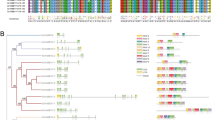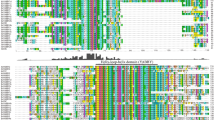Abstract
The establishment of ad-abaxial polarity is an important characteristic of the development of lateral organs in plants. YABBY genes encode higher plant-specific nuclear proteins which play critical roles in promoting abaxial cell fate. IaYABBY2 (IaYAB2, Genbank accession no. KF250432), isolated from Incarvillea arguta, is a member of YABBY gene family. Sequence characterization and phylogenetic analyses show that IaYABBY2 is a member of the YAB2 subfamily of Arabidopsis thaliana. Subcellular localization analysis indicates that IaYABBY2 is localized in the nucleus. Ectopic expression of IaYABBY2 in Arabidopsis plants resulted in the partial abaxialization of adaxial epidermises of leaves and sepals and development defect of florescence. The transgenic lines also showed higher level of anthocyanin content and photosynthesis capability after differential environment stress. These results indicate that the IaYABBY2 functions in the ad-abaxial polarity, development of shoot apical meristem, and environmental stress.









Similar content being viewed by others
References
Bai X, Yang L, Yang YQ, Ahmad P, Yang YP, Hu X (2011) Deciphering the protective role of nitric oxide against salt stress at the physiological and proteomic levels in maize. J Proteome Res 10(10):4349–4364
Bowman JL (2000) The YABBY gene family and abaxial cell fate. Curr Opin Plant Biol 3(1):17–22
Bowman JL, Eshed Y, Baum SF (2002) Establishment of polarity in angiosperm lateral organs. Trends Genet 18(3):134–141
Bowman JL, Smyth DR (1999) CRABS CLAW, a gene that regulates carpel and nectary development in Arabidopsis, encodes a novel protein with zinc finger and helix-loop-helix domains. Development 126(11):2387–2396
Brand U, Fletcher JC, Hobe M, Meyerowitz EM, Simon R (2000) Dependence of stem cell fate in Arabidopsis on a feedback loop regulated by CLV3 activity. Science 289:617–619
Clough SJ, Bent AF (1998) Floral dip: a simplified method for Agrobacterium-mediated transformation of Arabidopsis thaliana. Plant J 16(6):735–743
Dodsworth S (2009) A diverse and intricate signalling network regulates stem cell fate in the shoot apical meristem. Dev Biol 336(1):1–9
Fan YZ, Zhong ZM, Zhang XZ (2011) A comparative analysis of photosynthetic characteristics of hulless barley at two altitudes on the Tibetan Plateau. Photosynthetica 49(1):112–118
Fernandez L, Torregrosa L, Terrier N, Sreekantan L, Grimplet J, Davies C, Thomas M, Romieu C, Ageorges A (2007) Identification of genes associated with flesh morphogenesis during grapevine fruit development. Plant Mol Biol 63(3):307–323
Goldshmidt A, Alvarez JP, Bowman JL, Eshed Y (2008) Signals derived from YABBY gene activities in organ primordia regulate growth and partitioning of Arabidopsis shoot apical meristems. Plant Cell 20(5):1217–1230
Golz JF, Roccaro M, Kuzoff R, Hudson A (2004) GRAMINIFOLIA promotes growth and polarity of Antirrhinum leaves. Development 131(15):3661–3670
Lee J-Y, Baum SF, Alvarez J, Patel A, Chitwood DH, Bowman JL (2005a) Activation of CRABS CLAW in the Nectaries and Carpels of Arabidopsis. Plant Cell 17(1):25–36
Lee J-Y, Baum SF, Oh S-H, Jiang C-Z, Chen J-C, Bowman JL (2005b) Recruitment of CRABS CLAW to promote nectary development within the eudicot clade. Development 132(22):5021–5032
Matsumoto N, Okada K (2001) A homeobox gene, PRESSED FLOWER, regulates lateral axis-dependent development of Arabidopsis flowers. Genes Dev 15(24):3355–3364
Mayer KF, Schoof H, Haecker A, Lenhard M, Jurgens G, Laux T (1998) Role of WUSCHEL in regulating stem cell fate in the Arabidopsis shoot meristem. Cell 95(6):805–815
Miyashima S, Sebastian J, Lee JY, Helariutta Y (2012) Stem cell function during plant vascular development. EMBO J 32(2):178–193
Muller R, Borghi L, Kwiatkowska D, Laufs P, Simon R (2006) Dynamic and compensatory responses of Arabidopsis shoot and floral meristems to CLV3 signaling. Plant Cell 18(5):1188–1198
Qi T, Song S, Ren Q, Wu D, Huang H, Chen Y, Fan M, Peng W, Ren C, Xie D (2013) The jasmonate-ZIM-domain proteins interact with the WD-repeat/bHLH/MYB complexes to regulate jasmonate-mediated anthocyanin accumulation and trichome initiation in Arabidopsis thaliana. Plant Cell 23:1795–1814
Sarkar AK, Luijten M, Miyashima S, Lenhard M, Hashimoto T, Nakajima K, Scheres B, Heidstra R, Laux T (2007) Conserved factors regulate signalling in Arabidopsis thaliana shoot and root stem cell organizers. Nature 446(7137):811–814
Schoof H, Lenhard M, Haecker A, Mayer KF, Jurgens G, Laux T (2000) The stem cell population of Arabidopsis shoot meristems in maintained by a regulatory loop between the CLAVATA and WUSCHEL genes. Cell 100(6):635–644
Sieber P, Gheyselinck J, Gross-Hardt R, Laux T, Grossniklaus U, Schneitz K (2004) Pattern formation during early ovule development in Arabidopsis thaliana. Dev Biol 273(2):321–334
Siegfried KR, Eshed Y, Baum SF, Otsuga D, Drews GN, Bowman JL (1999) Members of the YABBY gene family specify abaxial cell fate in Arabidopsis. Development 126(18):4117–4128
Simon MK, Williams LA, Brady-Passerini K, Brown RH, Gasser CS (2012) Positive- and negative-acting regulatory elements contribute to the tissue-specific expression of INNER NO OUTER, a YABBY-type transcription factor gene in Arabidopsis. BMC Plant Biol 12:214
Sun XD, Feng ZH, Meng LS (2012) Ectopic expression of the Arabidopsis ASYMMETRIC LEAVES2-LIKE5 (ASL5) gene in cockscomb (Celosia cristata) generates vascular-pattern modifications in lateral organs. Plant Cell Tissue Organ Cult 110:163–169
Sun XD, Feng ZH, Meng LS, Zhu J, Geitmann A (2013) Arabidopsis ASL11/LBD15 is involved in shoot apical meristem development and regulates WUS expression. Planta 237(5):1367–1378
Sun XD, Meng LS, Feng ZH, Zhu J (2010) ASYMMETRIC LEAVES2-LIKE11 gene, a member of the AS2/LOB family of Arabidopsis, causes pleiotropic alteration in transgenic cockscomb (Celosia cristata). Plant Cell Tissue Organ Cult 101(2):193–200
Toriba T, Harada K, Takamura A, Nakamura H, Ichikawa H, Suzaki T, Hirano HY (2007) Molecular characterization the YABBY gene family in Oryza sativa and expression analysis of OsYABBY1. Mol Genet Genomics 277(5):457–468
Xu H, Wang X, Sun X, Shi Q, Yang F, Du D (2008) Molecular cloning and characterization of a cucumber MAP kinase gene in response to excess NO3 − and other abiotic stresses. Sci Hortic 117(1):1–8
Yamada T, Sy Y, Hirayama Y, Imaichi R, Kato M, Gasser CS (2011) Ancestral expression patterns and evolutionary diversification of YABBY genes in angiosperms. Plant J 67(1):26–36
Yang X, Li X, Li B, Zhang D (2013) Identification of genes differentially expressed in shoot apical meristems and in mature xylem of Populus tomentosa. Plant Mol Biol Report. doi:10.1007/s11105-013-0660-6
Zheng J, Xi M, Lü Y, Lu Y, Shi J (2013) Transcriptional analysis provides new insights into cold- and dehydration-tolerance signaling pathways and on regulation of stem cell activity in the vascular cambium of poplar. Plant Mol Biol Report 31(1):75–86
Acknowledgments
This article was supported by the Young Academic and Technical Leader Raising Foundation of Yunnan Province (no. 2012HB041).
Author information
Authors and Affiliations
Corresponding author
Additional information
Xudong Sun and Yanlong Guan contributed equally to this study.
Rights and permissions
About this article
Cite this article
Sun, X., Guan, Y. & Hu, X. Isolation and Characterization of IaYABBY2 Gene from Incarvillea arguta . Plant Mol Biol Rep 32, 1219–1227 (2014). https://doi.org/10.1007/s11105-014-0725-1
Published:
Issue Date:
DOI: https://doi.org/10.1007/s11105-014-0725-1




